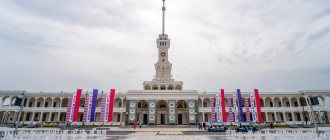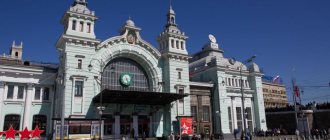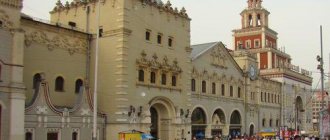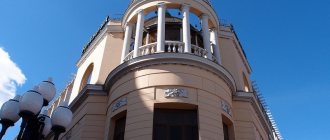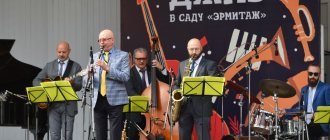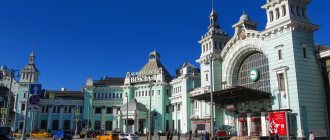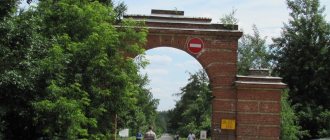There are two river stations in Moscow - Northern and Southern. The Northern Station is the former Khimki river station. The complex structure is the main structure of the canal named after. Moscow. Khimki Station is part of the Moscow River Shipping Company OJSC. In 1987, the station building was recognized as an architectural monument. The historical and cultural value is of national importance; in the register of cultural heritage monuments, the station building is classified as a regional memorial site.
The Northern Station is located on territory belonging to the Northern Administrative District of Moscow, on the coast of the Khimki Reservoir. The building is surrounded by a large park. The building has a height of 48 m, a façade length of 150 m, and a spire length of 27 m.
In the very premises of the river station, a small museum is open to visitors, which is dedicated to the development of the North. Also located on the premises is an office selling tours along the Moscow River and the Volga-Volga restaurant. It was opened simultaneously with the station building, in 1937. The ceiling height of this old restaurant reaches 8 meters. Seagulls comfortably sat on the sky-blue ceiling. The interior of the restaurant is very beautiful; it’s worth coming here just to admire the interior decoration. Due to its magnificence, Volga-Volga is often the location for television filming.
“Star from the Spasskaya Tower”: the main myth of the river station
The most widespread and completely untrue myth of the River Station is associated with the star that adorns its spire. It is believed that between 1935 and 1937 it crowned the Kremlin's Spasskaya Tower, and after that it was moved to the station spire. The stars are really similar. They have two contours, and in both cases the rays diverge from the center to the inner contour. The stone-encrusted hammers and sickles that decorate the stars also have a lot in common.
Installation of a star on the spire of the River Station, 1937 (
)
Installation of a star in the Kremlin, 1935 ()
But the stars differ significantly in details: the contours of the station star have a rectangular cross-section, the front surfaces of the contours are covered with longitudinal grooves and are connected to each other by hidden connections. The outlines of the old star from the Spasskaya Tower were
, had a triangular cross-section and were connected to each other by jumpers at the vertices. Moreover, they were produced by different factories: the star for the Spasskaya Tower was made at the Zhukovsky Central Aerohydrodynamic Institute (TsAGI), and the Rechnoy star was made at Plant No. 81 named after Molotov.
The star was dismantled from the Spasskaya Tower in October 1937, along with the original stars from the other towers. The star was installed on the spire of the River Station in the spring of 1937 before the grand opening of the canal, as evidenced by photographs of this period. In addition, in publications of the 1930s, including articles written by the author of the project, Rukhlyadev, it is mentioned that a star “like the Kremlin ones” would be installed on top of the spire of the Northern River Station, and not one of the already existing ones.
In the end, the stars were removed from the Kremlin towers because they had become too dark and no longer looked representative. It is unlikely that they would install a darkened and wind-worn star on the central object of such an ambitious complex as the Moscow-Volga canal.
Dismantling of the star of the Northern River Station in July 2021 / Photo by the author
Now the star of the River Station has been dismantled from the spire and sent for restoration to the workshop, which also took part in the restoration of the metal elements of the VDNKh complex. Over nine decades, the star, of course, has darkened significantly. Hammers and sickles are especially heavily patinated. The Ural gems with which they are inlaid also require cleaning, but most of these stones are genuine.
Cost of tickets for pleasure flights
- An hour-long walk along the Khimki Reservoir will cost from 250 rubles for an adult and 150 rubles for a child
- The cost of a trip to Troitskoye beach will be from 800 and 400 rubles, respectively.
- Pleasure ticket offices are open daily in summer from 11:00 to 21:00.
The Northern River Station is a popular place for relaxation and walking; it is a beautiful and romantic place. You will have a beautiful view of the snow-white ships and expanses of water, and you will be able to feel the unforgettable spirit of travel.
Error in the Register of Moscow Monuments
An inexplicable absurdity is associated with the name of the chief architect of the River Station building. In the register of cultural heritage sites in Moscow, a mistake was made in his initials: instead of A. M. Rukhlyadev, A. I. Rukhlyadev is indicated there. To correct it, a whole act of state historical and cultural examination is needed, which no one has yet undertaken to develop. Of course, when journalists write about this monument, they often copy information from the registry with an error, without checking the correct name.
Documentary film about the construction of the Moscow-Volga canal
In addition, many publications mention architect Vladimir Krinsky among the authors of the Northern River Station project. This is probably due to the fact that he and Rukhlyadev regularly worked together since the 1920s, including on the project of the Karamyshevsky hydroelectric complex of the Moscow-Volga canal. But Rukhlyadev designed the station building alone. This is confirmed, in particular, by the fact that none of the numerous drawings of the station contain Krinsky’s signature or surname. At the same time, Rukhlyadev’s signatures are on each of them, including sketches and sketches.
How to get there
The pier can be reached by metro. The pier is the metro station. "River Station".
- You need to get out of the first carriage.
- Go around the metro lobby on the right.
- Next, go to the Leningradskoye Highway, to the underground passage.
- At the crossing you need to go to the other side of the road.
- After exiting the passage, descend to the entrance of the Northern Port.
- The first gate is for entry, go further a little to the right. The landmark is a one-story building.
- Along the building there is access to the pier.
Address: Moscow, Leningradskoe highway, building No. 51
missing clock mechanism and repainted dial
One more question still remains unclear. There is a version that the clock mechanism on the tower of the River Station (or part of it) was moved from the bell tower of the Resurrection Cathedral in Volokolamsk. A study of archival documents could neither confirm nor refute this hypothesis. When the restoration work began, the clock mechanism was already missing, and no traces remained of it. During the restoration process, a new mechanism will be installed in the tower.
Brickwork and tower cladding / Material from the Technical Archive of the Design and Technical Service of the Federal State Budgetary Institution “Moscow Canal”. Photo by author ()
A total of five hours were used in the design of the station. Four dials of the same type are installed on the third tier of the tower, the fifth dial is located on the slope of the vault in the restaurant hall. The latter fully corresponds to the sketches signed by the architect from the canal archive. The tower clock differed somewhat from the archival sketches.
Dimensional drawing of the vestibule capital / Material from the Technical Archive of the Design and Technical Service of the Federal State Budgetary Institution "Moscow Canal". Photo by author ()
Drawing of a sliding gate leaf / Material from the Technical Archive of the Design and Technical Service of the Federal State Budgetary Institution "Moscow Canal". Photo by author ()
However, during the restoration work, a segment of one of the dials was cleared, and it turned out that the drawing, discovered by the restorers under a layer of late painting, completely replicates the author's intention. It turned out that the dials were repainted: their diameter increased, instead of gold paint for the minute divisions, silver was used, and the numbers and hands were covered with gray enamel. Now the dials will be cleaned and will return to their original appearance.
Saratov
The Saratov River Station is also very picturesque and large. Today it continues to fulfill its functions; you can go on a trip to Astrakhan, Volgograd and the most distant cities. You can check the schedule on the official website.
The most beautiful ships sail from here every day. If desired, this type of transport can even be rented to conduct an individual tour, for example, when celebrating a wedding, anniversary or business meetings.
The station is located on the right coast of the Volgograd reservoir.
How many times has the spire risen
All four massive anchors installed on the third tier of the tower were originally bronzed and covered with colorless enamel on top. However, they were soon covered with black paint, because under the influence of weather conditions the anchors quickly darkened, stopped shining and became invisible against the background of a light wall. After restoration, the anchors will also remain black.
Window drawing / Material from the Technical Archive of the Design and Technical Service of the Federal State Budgetary Institution "Moscow Canal". Photo by author ()
On the lower tier of the tower were installed concrete figures of a Red Army soldier, a Red Navy man, a southern collective farmer and a northern worker. According to the architect's original plan, they were supposed to be covered with bronze paint. However, this was not done. This spring, all the figures were dismantled, and copies were made from casts of them - also made of concrete. The originals will be exhibited in the new canal history museum, the opening of which remains in plans, and copies will be installed on the tower.
The building's 27-meter spire and its retractable mechanism deserve special attention. According to the project, it was supposed to serve as a lighthouse for ships, rise at the beginning of navigation and descend at its completion. However, this happened much less frequently. It is reliably known about three cases when the spire rose above the station building: twice in the Soviet period - at the grand opening of the canal and after the end of the war - and once in the year of the celebration of the 850th anniversary of Moscow. This is probably due to the fact that the tall thin spire, topped with a massive star, was unable to withstand the winds, the strength of which is quite high in the open space of the Khimki Reservoir.
Arkhangelsk
There is a beautiful spacious river station here, which was built over 4 centuries ago. The building is located at the mouth of the Northern Dvina River, which flows into the White Sea. The port is an important point of maritime communication.
During the Second World War, this was the only station through which it was possible to deliver weapons from abroad, as well as medicines, various equipment, and food.
This port is located on the Russian 500 ruble banknote.
Four fountains instead of two
The fountains located in the southern and northern courtyards formed by galleries suffered the most serious damage as a result of long-term neglect. In the southern courtyard there was a fountain “South” with nine metal dolphins playing with glass balls in streams of water. On the opposite side there was the “North” fountain with figures of marble polar bears and a bird colony made of metal loons and geese by sculptor Lev Kardashev.
To this day, only the stone elements of the fountains have been fully preserved, requiring serious restoration intervention. Of the nine dolphin figures, only three survived, discovered by restorers in the basement of the building during its first inspection. The birds were not preserved.
General view, plan and diagram of the southern fountain with figures of dolphins / Material from the Technical Archive of the Design and Technical Service of the Federal State Budgetary Institution "Moscow Canal". Photo by author ()
The southern fountain is quite well known from photographs from the 1950s to the 1970s, and sketches and drawings of it were discovered in the canal archives. Other sketches and models were discovered in the archives of the family of the author of this composition, sculptor Ivan Efimov. Unfortunately, it was not possible to find such an abundance of materials with the northern fountain, and its restoration is still an unsolved problem.
By the way, few people know about this, but there are not two fountains at the station, but four.
In addition to the two large fountains, on the side of the River façade, at the basement level, in semicircular niches at the ends of the building there are two small fontanelle fountains. Initially, a stream of water flowed from a protoma in the form of a sturgeon's head into a granite bowl. The location of these fountains was not chosen by chance and should have been associated with through holes in the sides for draining water from the deck, scuppers. Now the fountains are not functioning, but after the restoration is completed they should work again.
From the life history of the Northern Moscow port
During the years of the USSR, the channel named after. Moscow was intended for transporting building materials, timber, grain, oil, and coal. Passengers also actively moved through the water.
On March 23, 1987, the River Northern Station/Port officially became an architectural monument of all-Union status. Out of habit, Muscovites came to the shore to take a walk in their favorite places, but passenger transportation ceased to be widespread, and the buildings began to fall into disrepair.
By 2005, the plaster and majolica edging began to crumble, the roof waterproofing was damaged, and the steps were deformed. The restaurant received regular customers, but their number was decreasing.
In 2010, the complex was closed for reconstruction; a project was drawn up, but work did not begin for quite some time.
In 2015, the city took ownership of the buildings of the River North Station and announced a restoration competition. Unfortunately, even on the 80th anniversary of the cruise navigation of the Northern Port, the premises were in disrepair. It was sad to see the decor that was beautiful in the past, now crumpled, and damaged elements of the walls and façade. Archnadzor had no choice but to include the neglected complex in the Red Book.
But finally, a worthy contractor was found who was entrusted to begin restoration work based on drawings and documents from the archive.
Return of the Roof Terrace
The reconstruction of the station implies not only the resumption of its work, but also the creation of public spaces on its territory. The plan is especially interesting in light of the fact that initially the architect Rukhlyadev tried to adapt the building to year-round use and generally increase its functionality. He conceived his station not only as a “transport” structure, but also as a “resting place”, designed for transit passengers, sightseers and athletes.
Option for the end facade / Material from the Technical Archive of the Design and Technical Service of the Federal State Budgetary Institution "Moscow Canal". Photo by author ()
The “roof-terrace,” as Alexey Rukhlyadev called it, was supposed to attract vacationers and connect the building with “prospects for the surrounding landscape.” After the restoration, the observation decks and roof will be accessible again.
archive in bags
For many decades, the canal archive funds were completely classified, since they contained information about the direct builders of the canal - the prisoners of Dmitlag.
In the first years of the Great Patriotic War, the archive was evacuated to Ulyanovsk. During the evacuation it was divided into two parts. One consisted of design and working documentation, the second - from the personal files of Gulag prisoners. After the war, the first part more or less entirely returned to Moscow.
Plan of the first floor of the station with explication of the premises, 1937 / Material from the Technical Archive of the Design and Technical Service of the Federal State Budgetary Institution "Moscow Canal". Photo by author ()
The fate of the second part is not known for certain, and something can be learned about it only from the recollections of eyewitnesses. One of the archive employees, who was evacuated with him, told me that before returning to Moscow she watched the loading of documents onto the ship. According to her, MGB officers simply threw bags with personal files into the Volga. At the same time, the sorting of materials with working documentation was carried out “by eye”: the bag with documents was opened, and the first case that came across was taken out of it. Based on its contents, a decision was made whether to keep the rest of the contents of the entire bag or not. Therefore, there are strange gaps in the project documentation.
Some of the files of Dmitlag prisoners nevertheless returned from evacuation, but were destroyed already in the 1990s when the archive was transferred to the jurisdiction of the Federal State Budgetary Institution “Moscow Canal”. Then the last bags of cases were burned by unknown people.
Until recently, a significant part of the fund remained in bags. Several years ago, one of the employees of the Federal State Budgetary Institution “Moscow Canal” began sorting and systematizing documents in her free time. It was thanks to her efforts that archival materials were discovered.
The collections still contain unstudied and unpublished documents on locks and other canal structures. Some of the materials are still stored - or rather, perishing - in bags.
After restoration
It is remarkable that during the restoration it was possible to preserve most of the original elements and interior details, and the lost parts were restored. 17 berths have been repaired, now the station can receive or dispatch up to four ships at a time and up to 24 ships per day, the station's capacity is more than 1.5 million passengers per season.
The main destinations remain St. Petersburg, Yaroslavl, Kazan, Nizhny Novgorod, Astrakhan, Rostov-on-Don, Volgograd, Ples, Cherepovets, Uglich, Kostroma, Samara, Saratov, Gorodets, Myshkin, Valaam, Tver, Tutaev. It would take a very long time to list all the features, achievements and innovations, but if you wish, you can find this information yourself on the Internet.
